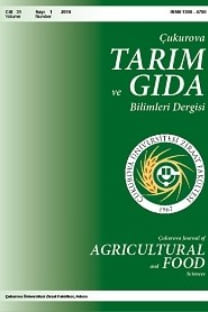Gölgede Kurutulmuş Öksürük Otunun (Tussilago farfara L.) Uçucu Bileşiklerinin Taşıyıcı ve Tuzak Yöntemiyle Belirlenmesi
Tussilago farfara L., Öksürük otu, purge and trap, , aroma.
Volatile Compounds of Shade-Dried Tussilago farfara L. Using Purge and Trap Extraction Technique
Tussilago farfara L., Coltsfoot, purge and trap, , aroma,
___
- Breitmaier E., (2006) Terpenes: Importance, general structure, and biosynthesis. Terpenes: Flavors, Fragrances, Pharmaca, Pheromones, 1-9.
- Casabianca H., Graff J. B., Faugier V., Fleig F., Grenier C., (1998) Enantiomeric distribution studies of linalool and linalyl acetate. A powerful tool for authenticity control of essential oils. J High Res Chrom, 21(2), 107-112.
- Chanaj-Kaczmarek J., Wojcińska M. & Matławska I., (2013) Phenolics in the Tussilago farfara leaves. Herba Pol, 59, 35-43.
- Chang-Tian Li., Yan-Peng Liu, Feng-Cheng He, Yu Li., (2012) In vitro antioxidant activities of Tussilago farfara, a new record species to Changbai Mountain." Chin J Nat Med., 10, 260, 260-262.
- Dudareva N., Pichersky E., Gershenzon J., (2004) Biochemistry of plant volatiles. Plant Physiol, 135(4), 1893-1902.
- Ferrer D. B., Venskutonis P. R., Talou T., Zebib B., Ferrer J. M. B., Merah O., (2016) Potential interest of Tussilago farfara (L.) whole plant of Lithuanian and French origin for essential oil extraction. Am J Essent Oils Nat Prod, 4(3), 12-15.
- Hwangbo C., Lee H. S., Park J., Choe J., Lee J. H., (2009) The anti-inflammatory effect of tussilagone, from Tussilago farfara, is mediated by the induction of heme oxygenase-1 in murine macrophages. Int Immunopharmacol, 9(13), 1578-1584.
- Judzentiene A., Budiene J., (2011) Volatile oils of flowers and stems of Tussilago farfara L. from Lithuania. J Essent Oil Bear Plant, 14(4), 413-416.
- Kikuchi M., Suzuki N., (1992) Studies on the constituents of Tussilago farfara L. II. Structures of new sesquiterpenoids isolated from the flower buds, Chem Pharm Bull, 40, 2753-2755.
- Knee M., Hatfield S. G., (1981) The metabolism of alcohols by apple fruit tissue. J Sci Food Agr, 32(6), 593-600.
- Kokoska L., Polesny Z., Rada V., Nepovim A., Vanek T., (2002) Screening of some Siberian medicinal plants for antimicrobial activity. J Ethnopharmacol, 82(1), 51-53.
- Li Z.-Y., Zhi H.-J., Zhang F.-S., Sun H.-F., Zhang L.-Z., Jia J.-P., Xing J., Qin X.-M., (2013) Metabolomic profiling of the antitussive and expectorant plant Tussilago farfara L. by nuclear magnetic resonance spectroscopy and multivariate data analysis, J Pharm Biomed Anal, 75, 158-164.
- Liu C., Qin K., Qi Y., Li K., Li Y. , Jia B., (2014) Optimization of ultrasonic extraction of total flavonoids from Tussilago farfara L. using response surface methodology, Int J Pharma Sci, 69, 311-315.
- Poste L. M., (1991) Laboratory methods for sensory analysis of food (No. 641.1 P6 1991). Canada. Department of Agriculture.
- Smyrska-Wieleba, N., Wojtanowski, K. K., Mroczek T., (2016) Comparative HILIC/ESI-QTOF-MS and HPTLC studies of pyrrolizidine alkaloids in flowers of Tussilago farfara and roots of Arnebia euchroma. Phytochem Lett.
- Song K., Lee K. J. , Kim Y. S., (2017) Development of an efficient fractionation method for the preparative separation of sesquiterpenoids from Tussilago farfara by counter-current chromatography, J Chromatogr A, 1489, 107-114.
- Sonmezdag A. S., Kelebek H., Selli S., (2016) Characterization of aroma-active and phenolic profiles of wild thyme (Thymus serpyllum) by GC-MS-Olfactometry and LC-ESI-MS/MS. J Food Sci Technol, 53(4), 1957-1965.
- Sonmezdag A. S., Kelebek H., Selli S., (2017a) Identification of Aroma Compounds of Lamiaceae Species in Turkey Using the Purge and Trap Technique. Foods, 6(2), 10.
- Sonmezdag A. S., Kelebek H., Selli S., (2017b) Characterization and comparative evaluation of volatile, phenolic and antioxidant properties of pistachio (Pistacia vera L.) hull. J Essent Oil Res, 29(3), 262-270.
- Wang D., Fang L., Wang X., Qiu J., Huang L., (2011) Preparative separation and purification of sesquiterpenoids from Tussilago farfara L. by high-speed counter-current chromatography, Quím Nova, 34, 804-807.
- Wu D., Zhang M., Zhang C., Wang Z., (2008) Chromones from the flower buds of Tussilago farfara. Biochem Syst Ecol, 36(3), 219-222.
- Xu J., Sun X., Kang J., Liu F., Wang P., Ma J., Zhou H., Jin D.-Q., Ohizumi Y., Lee D., (2017) Chemical and biological profiles of Tussilago farfara: Structures, nitric oxide inhibitory activities, and interactions with iNOS protein, J Funct Foods, 32, 37-45.
- Xue S. Y., Li Z. Y., Zhi H. J., Sun H. F., Zhang L. Z., Guo X. Q., Qin X. M., (2012) Metabolic fingerprinting investigation of Tussilago farfara L. by GC–MS and multivariate data analysis. Biochem Syst Ecol, 41, 6-12.
- Yaoita Y., Kamazawa H., Kikuchi M., (1999) Structures of new oplopane-type sesquiterpenoids from the flower buds of Tussilago farfara L. Chem Pharm Bull, 47(5), 705-707.
- Zhao J., Evangelopoulos D., Bhakta S., Gray A. I., Seidel V., (2014) Antitubercular activity of Arctium lappa and Tussilago farfara extracts and constituents. J Ethnopharmacol, 155(1), 796-800.
- ISSN: 2636-7874
- Başlangıç: 1973
- Yayıncı: Çukurova Üniversitesi
Yağca Zenginleştirilmiş Sütten Sodyum Kazeinat İlavesiyle Üretilen Yumuşak Peynirlerin Özellikleri
Çağla ÖZBEK, Nuray GÜZELER, Fazeleh MESGARİ
Ali ERKILIÇ, Selda KOZAK ÖZDEMİR, Davut Soner AKGÜL
Okul Sütü Programı: Mersin İli Örneği
Erken Sütten Kesim Uygulamasının Holştayn Düvelerde Süt ve Döl Verim Özelliklerine Etkileri
Serap GÖNCÜ, Gökhan GÖKÇE, İbrahim EREZ
Seralarda Isıtma Kazan Kapasitelerinin Belirlenmesi Ve Dikkate Alınacak Kriterler
A. Nafi BAYTORUN, Özkan GÜĞERCİN
Dünya’da ve Türkiye’de Tıbbi ve Aromatik Bitkilerin Yeri ve Önemi
Veysi ACIBUCA, Dilek BOSTAN BUDAK
Patlıcanda Fusarium Solgunluğuna Dayanıklılık ve Mücadele Çalışmaları
Mine TÜRKTAŞ, Aysel Özgül KORAL
Atriplex spp. Çalı bitkilerinin hayvan beslemede kullanım olanakları
Esma PAYDAŞ, Reşit DEMİR, M. Şeref ŞELLİ
Domates Bitkisinde Hastalık Oluşturan Pospiviroid Cinsi Viroidler
